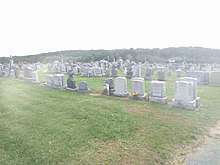St. Peter's Cemetery (Staten Island)
St. Peter's Cemetery is the oldest Roman Catholic cemetery on Staten Island. It is located at the junctures of Clove Road, Bement Avenue, and Tyler Place.

History
The cemetery was started in 1848. It is in two sections on both sides of Clove Road. The offices can be accessed from Tyler Place or by entry from Bement Avenue at Tyler Place. The oldest sections of the cemetery reflect the mostly Irish Catholic community that once comprised the Staten Island Catholic community.[1] St. Peter's cemetery was once a part of St. Peter's Catholic Parish which was the first Catholic church and parish on Staten Island one of the earliest Catholic parishes in New York City, founded in 1839 and originally catering to an Irish community of about 100 people.[1]
Since 1801, a Quarantine Hospital had been located in Tompkinsville, Staten Island,[2] and in the 1840s, during the Irish Potato Famine, many immigrant Irish who had fallen ill during their voyages were detained here. "During the entire Famine period, about 650,000 Irish arrived in New York harbor. All incoming passenger ships to New York had to stop for medical inspection. Anyone with fever was removed to the quarantine station on Staten Island and the ship itself was quarantined for 30 days."[3] Some Irish also settled in the area, thus increasing the Catholic presence on Staten Island substantially.[1] Some gravestones of Irish immigrants have the Irish County from which they emigrated inscribed.
Notable burials
- James Wheeler (treasurer) (July 4, 1843 – December 19, 1914), Richmond County Treasurer (1894–1898).[4] James Wheeler was born in Dublin, Ireland. In 1844 his family and he emigrated to West New Brighton, Staten Island where he would spend the rest of his life. He became one of the largest builders on Staten Island and founded the newspaper The Staten Islander.[5] James Wheeler was an Irish Famine immigrant, the son of Robert and Rose Wheeler and the brother of Patrick, Ann Donnelly, and Mary Cullen, all of whom are also buried near one another in St. Peter's Cemetery. He served as a Trustee of the Village of New Brighton 1878-1879 and was elected County Treasurer in 1894. He was the secretary of the Staten Island Building and Loan Association from 1878 until his death. He was also of the West New Brighton Council and the Royal Arcanum.
- Vincent Robert Capodanno (1929–1967), Roman Catholic priest killed in action serving as a United States Navy chaplain during the Vietnam War, posthumous recipient of the Medal of Honor
- Charles J. McCormack (1865–1915), second borough president of Staten Island
- Joseph F. Merrell (1926–1945), posthumous recipient of the Medal of Honor from the 3rd Battalion, 15th Infantry Regiment during World War II
See also
- St. Peter's Catholic Cemetery, New Gascony in Jefferson County is the state of Arkansas, near the community of Cornerstone. It was one of the first all-Catholic cemeteries in Arkansas, in the community of New Gascony. The site was flooded during the Great Flood of 1927, and some of the grave markers were lost in the flood waters. The original fence and the grave markers are all that remain of the original structures, but a monument was erected detailing the history of the cemetery and listing all the known who were buried there, as well as the unknown. The site is listed on the National Register of Historic Places by the United States Department of the Interior.
References
- "Medieval New York: Saint Peter's RC Church, Staten Island". Fordham.edu. Retrieved 2013-10-07.
- "Ellis Island Quarantine, NY: Deaths in Quarantine, 1909-1911". Freepages.genealogy.rootsweb.ancestry.com. Retrieved 2013-10-07.
- "Irish Potato Famine: Gone to America". The History Place. Retrieved 2013-10-07.
- http://search.proquest.com/docview/95138542
- Morris, Ira K. (1900), Morris's memorial history of Staten Island, New York, Volume 2, Memorial Pub. Co.